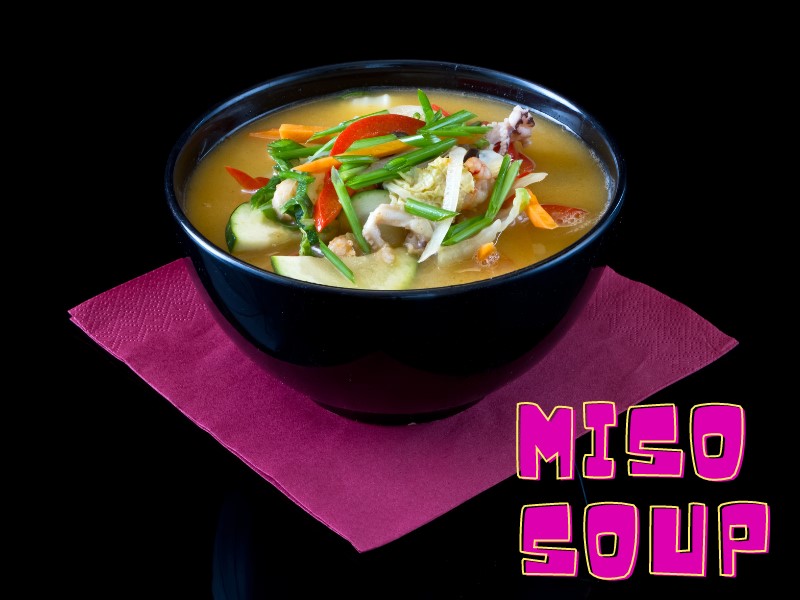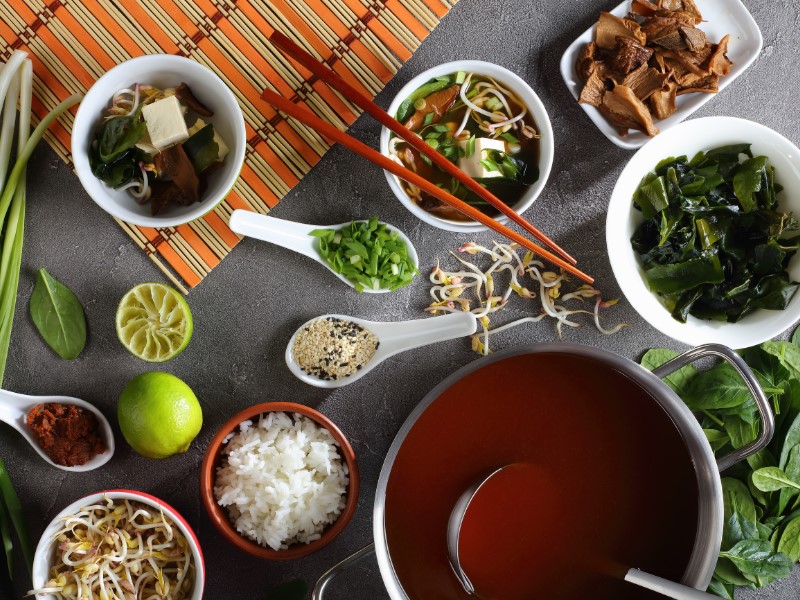How about enjoying a warm and nutritious miso soup on a cold, wintery night? Undeniably, delicious and nourishing. Moreover, finding the best Japanese restaurant in your region to savor an authentic miso soup is a real challenge. What if you cooked the World’s best miso soup yourself? Yes, you can! Because we’re bringing you the Super Chef’s Miso Soup recipe that is super easy too. Try this homemade miso soup recipe for a healthy and hygienic meal.
There are many traditional Japanese soups and stews that are easy to cook and are full of nutrition. Miso soup is delicious, has a variety of taste options and is highly customizable. Hence, you can add different vegetables, mushrooms, tofu, herbs, and spices according to your taste preference and availability of ingredients.
What is Miso Soup?
Miso soup is a Japanese delicacy that is served with steamed rice. Outside Japan, many restaurants serve miso soup as a side dish, an appetizer, or with a salad as a starter. In general, a Miso Soup is a broth seasoned with miso paste that is savory, warming, and nourishing. Moreover, preparing miso soup requires very little effort. All you need to do is make the broth, prepare the other add-ons and season.
Main Components of a Miso Soup Recipe:
If you have never tried miso soup before, this recipe will explain everything about it. One must, however, have detailed knowledge of a traditional recipe native to a specific region. So let’s begin exploring Japanese Cuisine. There are two main basic components of a miso soup recipe. One is the stock and the other is Japanese soybean paste. In addition, all other ingredients are customizable and you can add what you like. Traditionally, Japanese people used to add vegetables, vegetables, dried fish, tofu, and wakame to the miso soup stock.
Dashi (The Delectable Japanese Soup):
First of all, make sure that you cannot make miso soup with different types of broth. In other words, to cook genuine miso soup you must learn to make original Japanesedashi. Some people use instant dashi powder to make miso soup stock. However, such commercial products contain monosodium glutamate- quite toxic for a healthy metabolism. Also, the taste and aroma of miso soup fades quickly if you use instant dashi powder.
Well, it’s quite easy to make and there are many ways to cook it. Some people love vegan miso soup so they make dashi only with kombu kelp. Whereas, others love to add fish flakes, anchovies, and clams to make miso soup more nourishing.
Types of Dashi:
Awase Dashi:
You can make delicious Awase Dashi for your warm miso soup if you love both veggies and meat. It includes two main ingredients; the kombu kelp and dried bonito (smoked and fermented tuna) flakes. It’s super nourishing and soothing for tuna lovers.
Kombu Dashi:
For vegan miso soup lovers, kombu dashi is a perfect miso broth. It’s made by boiling water with kombu kelp and miso paste.
Iriko Dashi:
This miso soup dashi is made by adding anchovies and soybean paste to the boiling water. Anchovies have a strong flavor and are salty. Therefore, carefully add salt to the miso soup broth.

Miso ( The Savory Soybean Paste):
Miso is merely a fermented soybean paste. It is made by fermenting soybeans, steamed rice or cooked barley with Aspergillus oryzae. The Japanese call this fermentation culture koji that is seasoned with salt to bring the ultimate umami flavor. However, you can buy miso paste at the market since you cannot ferment it at home that way. There is a huge variety of miso pastes available in the market. They vary in color, taste, aroma, and saltiness. You can use just one type of miso or add 2-3 different miso pastes to create a unique flavor.
Types of Miso For Miso Soup:
Red Miso:
In Japanese, red misu is known as “aka miso” and is of dark reddish brown color. It’s dark hue clearly depicts the long fermentation period (upto 3 years). Also, because of the prolonged aging, red miso has a slightly bitter to pungent flavor with high saline content. Moreover, carefully add red miso to the miso soup since it can mask other beautiful flavors. It’s best for people who love strong flavors.
Yellow Miso:
Golden yellow to light brown colored miso paste is known as “shinshu miso” by the Japanese residents. The light color indicates a short fermentation period i.e. upto 1 year. With a tang of sweetness and an unmistakable burst of acidity, yellow miso imparts a lovely earthy, lightly salted taste. Furthermore, generously add yellow miso to take your classic miso soup recipe to the next level.
White Miso:
Shiro miso is the Japanese name for white miso of a light yellow to beige color. It is the most widely used miso to spice up Japanese dishes. Moreover, it is fermented for just a few weeks, which gives white miso a light salty and sweet flavor.
Add Ons ( Veggies, Mushrooms, and Tofu):
Mostly, people love tofu soup but there are many other ingredients you can add to your classic miso soup recipe. If you live in Japan, you will understand that drinking the same miso soup daily makes you bored. Therefore, to take your basic miso soup recipe to another level, try adding different combinations of vegetables and meat. You can add carrots, bonito flakes, anchovies, calms, radish, onions, potatoes, egg plant, mushrooms, somen noodles, spinach, and wakame seaweed. Moreover, the cooking time of ingredients should also be taken into account when adding ingredients.
Follow Just One Cookbook Miso Soup Recipe:

Awase Dashi Ingredients:
| Ingredients | Measurement |
| Water | 4 cups |
| Kombu Kelp (dried) | One 4 inches square piece |
| Bonito Flakes (dried) | 3 cups |
*If you want to enjoy vegan miso soup then, do not add any seafood like bonito flakes or anchovies.
* Exclude bonito flakes and replace with anchovies for Iriko dashi
Miso Soup Ingredients ( One Bowl):
| Dashi | 1 cup |
| Miso paste | 1 tablespoon |
| Green onion or scallions | As needed (for garnishing) |
| Other ingredients ( veggies, mushrooms, seafood) | As per preference |
How To Make Miso Soup: Instructions
First of all gather all ingredients and measure them accurately. Wash and clean any vegetables and other edibles. Additionally, pour out the miso paste into a bowl to facilitate adding it to miso soup.
Making Dashi For Miso Soup
The following steps will help you cook fresh dashi to make delicious miso soup. In addition, you can follow the same recipe to store the bulk amount of dashi.
Prepare Kombu Kelp:
Gently wipe off kombu kelp with a damp kitchen towel and do not attempt to remove the essential white powdery substance. If you want to relish the ultimate umami flavor of kombu kelp, it’s essential to soak it in water overnight. It’s indeed a Chef’s secret to make authentic and delectable miso soup. Nevertheless, if you are in a hurry then soak the kombu kelp for at least an hour.
Kombu Dashi:
The water in which your kombu kelp is soaked is known as kombu dashi. Pour this cold brew along with kombu kelp in a saucepan. Heat it at medium to low heat and remove kelp just as the kombu dashi begins to boil. At this point dashi will become a little slimy and bitter. However, if you do not want a strong and bitter flavor then, remove kombu kelp before dashi begins to simmer.
For non-vegetarian Miso soup lovers:
You can try Awase Dashi, if you are a non-vegan miso soup lover. For this purpose, add dried bonito flakes also known as Katsuobashi. Simmer katsuobushi with kombu dashi for about 30 to 60 seconds. Then, turn the flame off and let it steep for another ten minutes. Finally, strain your Awase dashi with the help of a sieve.
The Miso Soup Recipe:
Take a saucepan and pour a cup of your freshly cooked dashi. Now, it’s time to add your favorite ingredients. Make sure to add them in descending order according to their cooking time. First of all, add hard root vegetables and then the softer fish flakes and veggies. To prepare clam miso soup, add clams before dashi boils and heat till shells open. One, dashi boils, add soft veggies like cabbage, leeks, mushrooms. For a healthy breakfast miso soup, you can add boiled eggs in the end.
Ingredients to Add Before Dashi Boils
Carrots
Radish
Pumpkin
Onions
Potatoes
Turnip
Clams
Ingredients to Add After Dashi Boils
Bean sprouts
Cabbage
Brinjal
Egg
Mushrooms ( shiitake, maitake, nameko, enoki, shimeji)
Leeks
Somen Noodles
Spinach
Wakame seaweed
Soybean curd
Tofu (silken, deep fried, or medium-firm)
Add Miso Paste
Add one tablespoon of your favorite miso paste to a small amount of dashi, dissolve it, and add it to the pan. The ratio of dashi to miso paste is 1:1. You can double the amount according to your requirement. Do not over boil dashi after adding miso. Therefore, Chefs recommend adding hard ingredients first before boiling dashi and sofer later.
Add Tofu
One your delicious miso soup is ready, add tofu in it and gently stir. Do not add medium-firm tofu before boiling of dashi or else you will mash up tofu in miso soup.
Garnishing
Finally, add beautiful and scrumptious granishings. If you love wakame seaweed, rehydrate the dried wakame available in the market in a separate bowl. This step helps you wash away excess saltiness of wakame before adding it to miso soup. Then, add greens that don’t require much cooking. For example, green onions, scallions, yuzu, blanched spinach, and mitsuba. Another Pro tip is to add fragrant and colored garnishings right before you serve warm miso soup. Prepare fresh and serve hot!
Serving Ideas of Miso Soup Bowl:
- Miso Soup with Side Dishes: Nimono, Aenomo, or with pickles
- As Main Dish served with grilled fish or Sashimi (raw meat slices), or steamed rice
- As a soothing and nourishing soup
- Best for Healthy Breakfast, Brunch, Lunch, and Dinner
The benefits of drinking warm and healthy homemade miso soup:
Traditional Japanese miso soup is so healthy and nourishing that native people consume it daily. It’s just like Turkish people drink cava daily to keep them active, fit, and healthy. It helps you relieve cough, cold, and nasal congestion. Moreover, it keeps your muscles, collagen, bones, and cartilages strong and sturdy. Below are some very important advantages. In short, there is a long list of benefits of miso soup.

Its Whole Nutritious Value
Miso soup generously contains all essential nutrients you daily require to function well. It’s a rich source of essential vitamins and minerals that helps metabolism work well. Miso soup gives you proteins, carbohydrates, good fats, vitamin A, C, K, B Complex, iron, calcium, magnesium, copper, manganese, sodium, and zinc.
Healthy Gut:
Though miso soup is not a rich source of dietary fibre, it can still prevent and treat constipation. It is because iso soup contains miso paste that is a storehouse of probiotics. Drinking miso soup daily helps your Gut function well, improves nutrient absorption, and discards wastes with ease.
Stronger Bones:
Consuming miso soup as a natural supplement of calcium, magnesium, phosphorus, and potassium, helps fortify your bones and joints. Miso soup is the best ever formula you have ever tried for growing individuals.
Improves Heart Health:
Miso soup contains zero cholesterol, Vitamin K2, and potassium that all works to strengthen heart muscles. It also contains iron that helps proper oxygenation of blood and supports the circulatory system. A diet meal that helps you lower bad cholesterol is ultimately the best natural medicine to prevent various heart diseases.
Reduces Risk of Cancer:
Many studies elaborate that consuming miso soup daily can reduce the risk of stomach and liver cancer. Nevertheless, a more in-depth study is necessary to confirm this hypothesis.
FAQs:
What is the Nutritional Value of Miso Soup?
One miso soup bowl provides you a total of 40 calories. Miso soup is also a rich source of probiotics, vitamin K, Vitamin A, C, Vitamin B Complex, and minerals such as copper, manganese, sodium, iron, zinc, and calcium. Nevertheless, the nutritional values of miso soup vary as you include various healthy vegetables, seafood, and herbs.
| Nutrients | Measurement (grams) |
| Total Carbohydrates | 3 |
| Protein | 3 |
| Total Fat | 2 |
| Sodium | 0.86 |
How to Store Miso Soup?
Well, it’s best to cook and consume miso soup fresh. If you want miso soup to consume it tomorrow or the day after tomorrow, refrigerate it in a container. However, miso soup flavor and fragrance fade over time. Another great tip is to cook and store only dashi without miso paste. Moreover, if your miso soup contains vegetables that can go bad real fast, remove them before storing soup stock.
How to warm up Miso Soup?
Warm up the stored miso soup in a pan over medium to low flame. Do not heat up at a high flame or else you will burn all the essential nutrients.
Is it possible to cook and store a batch of dashi?
Yes, you can cook and store a bulk of dashi in your refrigerator or freezer to use for a variety of Japanese dishes. Put dashi in a closed container and keep in the fridge for about 5 days. If you wish to store dashi for two weeks, place it in the freezer. Moreover, if you already have prepared dashi then, preparation of miso soup will only require ten minutes. Simply, put frozen dashi in a pan and cook it with other ingredients.
Is it possible to add different miso pastes to Miso Soup?
Yes, of course, It’s a chef’s secret to add a blend of different miso pastes. This trick helps you get a unique blend of flavors i.e. sweetness, saltiness, bitterness, and acidity.

